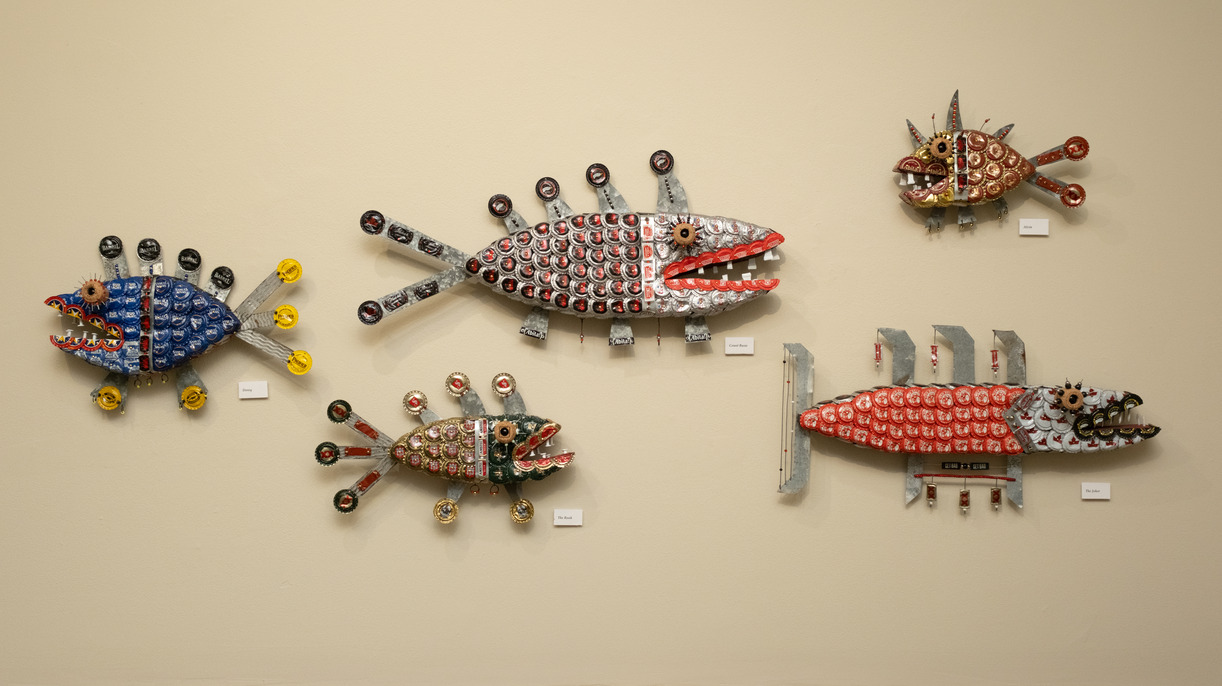
By Meghan E. Gattignolo
If you’ve ever felt a pang of guilt while throwing away a piece of trash, then you have something in common with Nashville artist Bill Henig. Henig may not call himself an “artivist,” but his art does send a message: one person’s trash is another’s treasure. The designated recycler of his friend group, Henig is usually the one to collect everyone’s empties for his own recycling bin at the end of a night of drinking beers around a campfire. One day, Henig came to realize the metal caps off his beer bottles, though unsuitable for recycling, could be put to better use in his studio.
Henig’s Beerakuda sculptures – named for the clever use of beer bottle caps as scales on fish – are an intuitive fusion of his interests in fishing, drinking beer socially with his friends, and his love for nature and the environment. Each fish Henig creates has its own character, and he names each one after finishing the piece.
Bill isn’t the first creative mind to turn discarded waste into interesting art. Artivists, artists who make a positive statement through their art by using non-traditional mediums such as garbage or unwanted items, are growing in number. Other artists around the world are turning trash into treasure, and – just like Hennig’s fish creations – they are colorful and incredibly inventive.
Here’s a few extraordinary artists keeping mundane objects out of landfills by transforming them into art supplies:

UK artist Robert Bradford takes pop culture to a new level with discarded plastic objects and old toys. A trained visual artist and psychotherapist, Bradford began in the early 2000s, considering a new life for his children’s old toys. He loves that each individual toy has its own secret history and a cultural footprint attached to the time and place in which it was played. Bradford exhibits his work around the world and enjoys praise for his eye-popping art pieces.

Ari Bayuaji picks up trash from the ocean – plastic fishing nets, old coral, sea glass – and makes imaginative sculptures and textiles with them. Bayuaji spent a lot of time on Bali’s beaches in his native Indonesia during the COVID lockdown. He had little else to do but walk the shoreline and pick up trash. Bayuaji found lots of colorful objects along the shore (particularly plastic ropes and fishing nets) and the rich colors made him wonder what he might be able to do with them. He has created imaginative sculptures and fabric with the materials he has found on the beaches. Inspired, Bayuaji also began a community art project in Bali and employed local residents to help with the work. Weaving the Oceans combines cultural weaving practices with found plastics to make new and useful materials.

Steven Rodrig, a Cuban-born American artist, has found a new way to use old circuit boards from his day job. Rodrig hated the thought of “perfect” printed computer circuit boards going to waste in landfills after they had served their intended functions. He longed to carry that design over from the information technology world to the art world. The fun titles Rodrig comes up with for his pieces, like “Sea Turtle Searches for Deep Data,” makes objects that seem devoid of artistic elegance suddenly whimsical.
Find Beerakuda: The Art of Bill Henig in the Harvill Gallery at the Customs House Museum & Cultural Center, now until July 28th. Don’t let them swim away before you check them out!

Meghan E. Gattignolo is a freelance writer and longtime Clarksville, TN resident. She loves to obsess about historical subjects and annoy her family daily with unsolicited random facts. Meghan holds a History B.A. from Austin Peay State University and lives in town with her husband and two children.